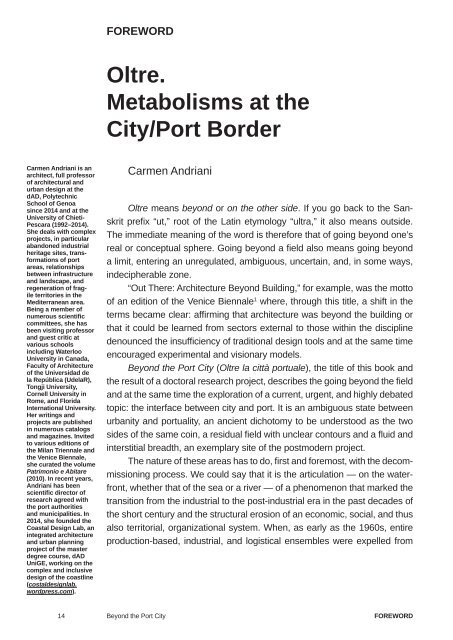You also want an ePaper? Increase the reach of your titles
YUMPU automatically turns print PDFs into web optimized ePapers that Google loves.
FOREWORD<br />
Oltre.<br />
Metabolisms at <strong>the</strong><br />
<strong>City</strong>/<strong>Port</strong> Border<br />
Carmen Andriani is an<br />
architect, full professor<br />
of architectural and<br />
urban design at <strong>the</strong><br />
dAD, Polytechnic<br />
School of Genoa<br />
since 2014 and at <strong>the</strong><br />
University of Chieti-<br />
Pescara (1992–2014).<br />
She deals with complex<br />
projects, in particular<br />
abandoned industrial<br />
heritage sites, transformations<br />
of port<br />
areas, relationships<br />
between infrastructure<br />
and landscape, and<br />
regeneration of fragile<br />
territories in <strong>the</strong><br />
Mediterranean area.<br />
Being a member of<br />
numerous scientific<br />
committees, she has<br />
been visiting professor<br />
and guest critic at<br />
various schools<br />
including Waterloo<br />
University in Canada,<br />
Faculty of Architecture<br />
of <strong>the</strong> Universidad de<br />
la República (UdelaR),<br />
Tongji University,<br />
Cornell University in<br />
Rome, and Florida<br />
International University.<br />
Her writings and<br />
projects are published<br />
in numerous catalogs<br />
and magazines. Invited<br />
to various editions of<br />
<strong>the</strong> Milan Triennale and<br />
<strong>the</strong> Venice Biennale,<br />
she curated <strong>the</strong> volume<br />
Patrimonio e Abitare<br />
(2010). In recent years,<br />
Andriani has been<br />
scientific director of<br />
research agreed with<br />
<strong>the</strong> port authorities<br />
and municipalities. In<br />
2014, she founded <strong>the</strong><br />
Coastal Design Lab, an<br />
integrated architecture<br />
and urban planning<br />
project of <strong>the</strong> master<br />
degree course, dAD<br />
UniGE, working on <strong>the</strong><br />
complex and inclusive<br />
design of <strong>the</strong> coastline<br />
(costaldesignlab.<br />
wordpress.com).<br />
Carmen Andriani<br />
Oltre means beyond or on <strong>the</strong> o<strong>the</strong>r side. If you go back to <strong>the</strong> Sanskrit<br />
prefix “ut,” root of <strong>the</strong> Latin etymology “ultra,” it also means outside.<br />
The immediate meaning of <strong>the</strong> word is <strong>the</strong>refore that of going beyond one’s<br />
real or conceptual sphere. Going beyond a field also means going beyond<br />
a limit, entering an unregulated, ambiguous, uncertain, and, in some ways,<br />
indecipherable zone.<br />
“Out There: Architecture <strong>Beyond</strong> Building,” for example, was <strong>the</strong> motto<br />
of an edition of <strong>the</strong> Venice Biennale 1 where, through this title, a shift in <strong>the</strong><br />
terms became clear: affirming that architecture was beyond <strong>the</strong> building or<br />
that it could be learned from sectors external to those within <strong>the</strong> discipline<br />
denounced <strong>the</strong> insufficiency of traditional design tools and at <strong>the</strong> same time<br />
encouraged experimental and visionary models.<br />
<strong>Beyond</strong> <strong>the</strong> <strong>Port</strong> <strong>City</strong> (Oltre la città portuale), <strong>the</strong> title of this book and<br />
<strong>the</strong> result of a doctoral research project, describes <strong>the</strong> going beyond <strong>the</strong> field<br />
and at <strong>the</strong> same time <strong>the</strong> exploration of a current, urgent, and highly debated<br />
topic: <strong>the</strong> interface between city and port. It is an ambiguous state between<br />
urbanity and portuality, an ancient dichotomy to be understood as <strong>the</strong> two<br />
sides of <strong>the</strong> same coin, a residual field with unclear contours and a fluid and<br />
interstitial breadth, an exemplary site of <strong>the</strong> postmodern project.<br />
The nature of <strong>the</strong>se areas has to do, first and foremost, with <strong>the</strong> decommissioning<br />
process. We could say that it is <strong>the</strong> articulation — on <strong>the</strong> waterfront,<br />
whe<strong>the</strong>r that of <strong>the</strong> sea or a river — of a phenomenon that marked <strong>the</strong><br />
transition from <strong>the</strong> industrial to <strong>the</strong> post-industrial era in <strong>the</strong> past decades of<br />
<strong>the</strong> short century and <strong>the</strong> structural erosion of an economic, social, and thus<br />
also territorial, organizational system. When, as early as <strong>the</strong> 1960s, entire<br />
production-based, industrial, and logistical ensembles were expelled from<br />
14 <strong>Beyond</strong> <strong>the</strong> <strong>Port</strong> <strong>City</strong><br />
FOREWORD


















